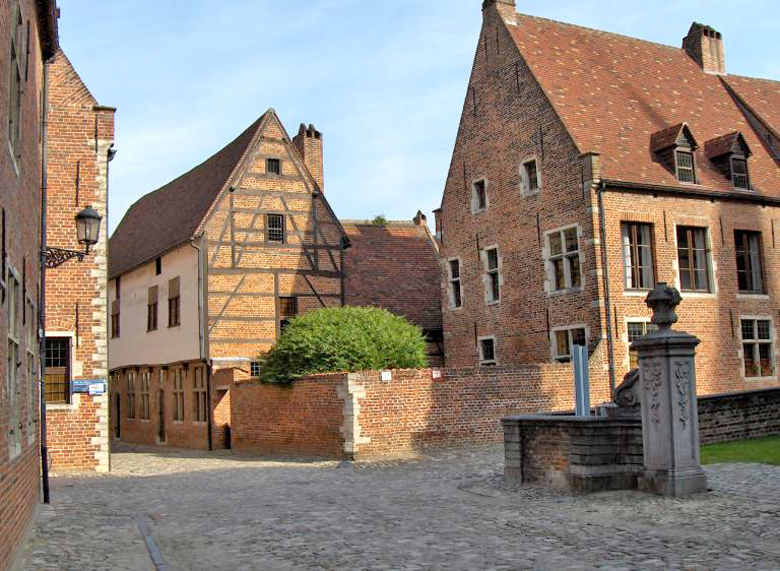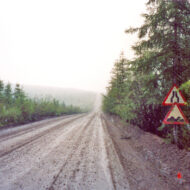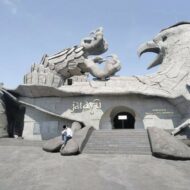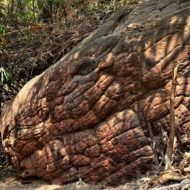The Great Beguinage of Leuven, is a well-preserved and completely restored historic center comprising a dozen streets in the south of the city of Leuven, Belgium.
The Great Beguinage in Leuven is a historical complex of buildings of the former community of beguines – followers of the religious movement that spread in Europe from the 12th century to the French Revolution of 1789.
For several centuries, representatives of the religious movement that arose in Brabant in the 12th century – beguines – lived here. Basically, these were women’s communities, they led a close monastic lifestyle, but did not take strict vows.
The Great Beguinage in Leuven is an imposing architectural complex consisting of about a hundred houses, several streets and squares. It covers an area of about 3 hectares, enclosed by walls. Currently, the Great Beguinage of Leuven, which is considered one of the largest in Belgium, belongs to the local university.
For several centuries, representatives of the religious movement that arose in Brabant in the 12th century – beguines – lived here. Basically, these were women’s communities, they led a close monastic lifestyle, but did not take strict vows.
The Great Beguinage in Leuven is an imposing architectural complex consisting of about a hundred houses, several streets and squares. It covers an area of about 3 hectares, enclosed by walls. Currently, the Great Beguinage of Leuven, which is considered one of the largest in Belgium, belongs to the local university.
Groot Begijnhof It was restored by the Catholic University of Leuven between 1964 and 1989, when it was purchased in 1962 from the Social Welfare Commission. The renovation took place in two phases. Most of the streets were rebuilt in the 1960s and 1970s under the supervision of Professor Lemaire ,The beguinage is currently owned by the Catholic University of Leuven and is used as a campus for students and invited guests of the university.
The beguinage has been listed as a historic monument since March 23, 1987 and appears in the Inventory of the Immovable Heritage of the Flemish Region, It has also been classified as a World Heritage Site by Unesco since December 2, 1998, its recognition being part of the file of the beguinages of Flanders.
The beguinage has been listed as a historic monument since March 23, 1987 and appears in the Inventory of the Immovable Heritage of the Flemish Region, It has also been classified as a World Heritage Site by Unesco since December 2, 1998, its recognition being part of the file of the beguinages of Flanders.
Access : Coordinates: 50.871, 4.696194 / You can get to the Leuven Beguinage by city buses No. 1, 2 – to the stop Leuven / Train From other cities to st. Leuven trains IC, ICT, L, P, S2, S9, S20.
Contents
The Great Beguinage of Leuven, is a well-preserved and completely restored historic center comprising a dozen streets in the south of the city of Leuven, Belgium.The Great Beguinage in Leuven is a historical complex of buildings of the former community of beguines – followers of the religious movement that spread in Europe from the 12th century to the French Revolution of 1789.
For several centuries, representatives of the religious movement that arose in Brabant in the 12th century – beguines – lived here. Basically, these were women’s communities, they led a close monastic lifestyle, but did not take strict vows.
The Great Beguinage in Leuven is an imposing architectural complex consisting of about a hundred houses, several streets and squares. It covers an area of about 3 hectares, enclosed by walls. Currently, the Great Beguinage of Leuven, which is considered one of the largest in Belgium, belongs to the local university.Groot Begijnhof It was restored by the Catholic University of Leuven between 1964 and 1989, when it was purchased in 1962 from the Social Welfare Commission. The renovation took place in two phases. Most of the streets were rebuilt in the 1960s and 1970s under the supervision of Professor Lemaire ,The beguinage is currently owned by the Catholic University of Leuven and is used as a campus for students and invited guests of the university.
The beguinage has been listed as a historic monument since March 23, 1987 and appears in the Inventory of the Immovable Heritage of the Flemish Region, It has also been classified as a World Heritage Site by Unesco since December 2, 1998, its recognition being part of the file of the beguinages of Flanders.
Highlights :
- The beguinage is crossed by two arms of the Dyle river and is therefore divided into three zones: a first zone located to the east of the Dyle, a second located between the two arms of the river, and the “Spaans Kwartier” (Spanish Quarter ) located west of the river.
- The “Grote Poort” or “Rechte Poort” is a neoclassical-style gate built in limestone in 1805, which opens onto the Rechtestraat, the street that runs along the facade. north of the Beguinage Church.
- Small Lane – Klein Straatken : Klein Straatken (Small Lane) connects Bovenstraat to Middenstraat / Heilige Geesttafel : At number 16 of the Middenstraat, opposite the church, stands a long building called “Heilige Geesttafel” (Table of the Holy Spirit).
- The Saint-Jean-Baptiste-du-Beguinage church :The construction of the Saint-Jean-Baptiste-du-Beguinage church began in 1305 as indicated by an inscription to the right of the north portal. / Bridges over the Dyle.
- Infirmary : Opposite the beguinage church stand the old farmhouse and the old infirmary, which now serve as a restaurant and place of celebration for the University of Louvain.
- Convent of the Seven Sorrows and half-timbered house : the “Convent of the Seven Sorrows” (“Convent van de Zeven Weeen”), at number 47.
- Heilige Geesttafel : This charitable institution of the sixteenth century had the mission of bringing aid to the poor, At number 16 of the Middenstraat, opposite the church
- Convent of Chièvres : An imposing building erected in 1561 / Convent of Lommel , To its right, at n ° 42, stands the House “Sint Ermelindis” from 16805, opposite the Convent of Chièvres.
- Spaanse quartier : The so-called Spanish Quarter, also known as Aborg – old castle. The names of the two quarters of the beguinage, Ten-Hove (In the courtyard) and Aborg (Old castle), seem to refer to an early settlement that existed on this site. Presumably, this was the court of the first Lord Leuven
- Saint-Nicolas House : At number 59 of the Benedenstraat stands the “Maison Saint-Nicolas”, whose facade mixes classical and baroque elements. / Couvent de la Vierge de la Présentation / Rue du Nouveau Couvent.
Activities : sightseeing / photo opportunities / walk in town with its old districts.
Go next : Leuven Town Hall / Old Market Square, The elongated, rectangular Stary Rynok square is located in the center of Leuven.















